
La crema de apio es una preparación alimenticia muy sabrosa, rica en nutrientes, vitaminas y minerales; su agradable sabor satisface el gusto de niños y adultos; se puede utilizar como plato de entrada o como la sopa del plato principal en el almuerzo. No deje de probarla en uno de esos días cuando los quebrantos de mucho trabajo o un resfriado nos molestan para comenzar al día; con una crema de apio en caldo de pollo o de res en el desayuno, se acomodará el día para empezar con energía.
El apio criollo es como se le conoce en Venezuela, o también arracacha, zanahoria blanca o racacha cultivado en otros países de América. El apio es un tubérculo rico en fibras que aporta energía al organismo y favorece el buen funcionamiento de las vías digestivas. El apio es rico en vitaminas y minerales como el hierro, calcio y fósforo.
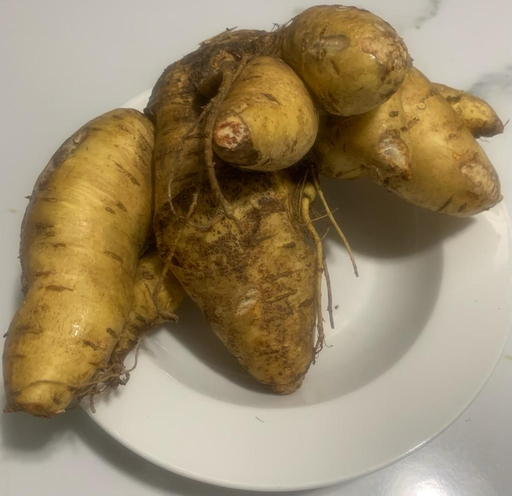
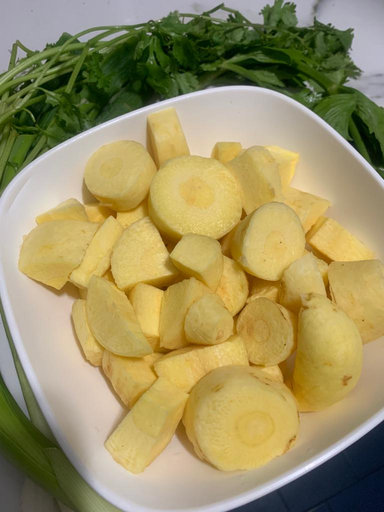
En esta receta que ofrecemos, combinaremos la acción alimenticia de otros vegetales como el ocumo blanco (malanga en otros países), la zanahoria, el jengibre, el ajoporro (puerro), cebollín, cebolla blanca, ajo, pimentón (morrón) y cilantro con los que preparemos una crema en caldo de res.
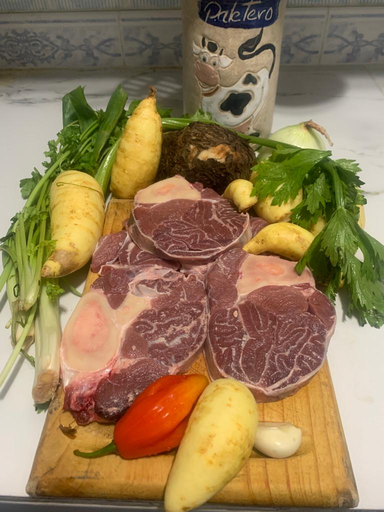
El caldo de res lo preparamos con tres o cuatro trozos de lagarto con hueso, como se le conoce en Venezuela, ossobuco o jarrete en otras latitudes: es el corte de las patas del ganado vacuno y otros animales, que lleva un hueso hueco con el tuétano y la carne es fibrosa. El tuétano es un componente gelatinoso que constituye la médula ósea, es una grasa que tiene propiedades nutritivas,consumida en porciones moderadas brinda beneficios a la salud.
En una olla grande colocamos unos 2,5 litros de agua y encendemos el fuego; colocamos los trozos de lagarto (más o menos 750 gramos), dos dientes de ajo, una cebolla mediana picada en cuatro, un ají dulce, una zanahoria pequeña, la mitad de un pimiento morrón mediano y una ramita de celery (apio España) dejamos la cocción por 25 minutos; cuando comience el hervor agregamos una cucharada de sal y un trocito de jengibre, del tamaño de un diente de ajo, y dejamos hervir por cinco minutos más.
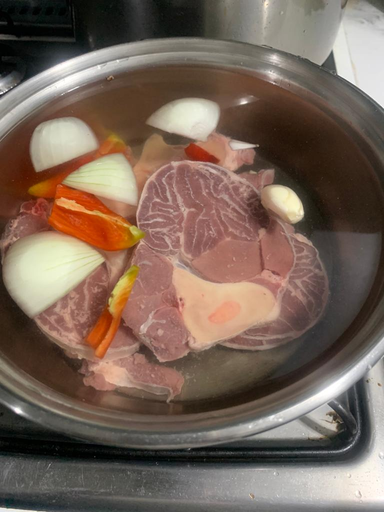
Mientras se cocina el caldo lavamos y picamos las otras verduras: el apio criollo (unos 750 grs.) se lava bien con una esponja rústica y agua, se corta en pequeños trozos; al ocumo blanco (250 grs.) se le quita con un cuchillo pequeño toda la concha y se corta en trozos medianos la parte blanca; las ramas de ajo porro y cebollín se lavan bien y se cortan en dos partes; al pimentón y al ají se le retiran las semillas.
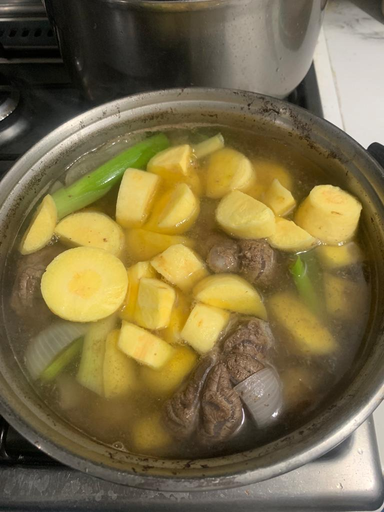
Una vez transcurridos los primeros 30 minutos de la cocción del lagarto, se apaga el fuego y se retiran de la olla todos los ingredientes (la carne y los vegetales) y se deja en la olla solo la mitad del caldo ( 1 ½ litro, más o menos); se agregan los trozos de apio, ocumo y el ajoporro; se agrega caldo para cubrir por completo estos vegetales crudos y se enciende el fuego. Transcurridos 10 minutos se rectifica la sal al gusto y se agregan el cebollín, el ají dulce y la otra mitad del pimentón. Cuando hierva el caldo, verifique con un tenedor que el apio y el ocumo ablandaron; de ser así, agregue una ramita de cilantro y apague el fuego. Con la ayuda de un cucharón coloque los trozos del apio y el ocumo en el vaso de la licuadora o en el procesador.
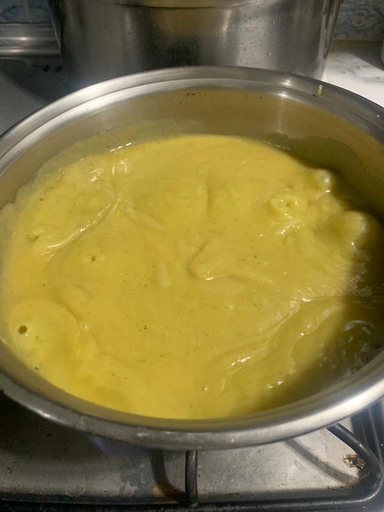
Agregue un poco del caldo para facilitar el licuado. Asegúrese de que la densidad o el espesor de la preparación tiene la consistencia de una crema y no de una sopa. Pruebe nuevamente la sal y, si es de su gusto, agregar una pizca de pimienta. Reserve el resto del caldo y los otros vegetales no utilizados en el licuado en otro recipiente para otra preparación; vierta el licuado en la olla y encienda el fuego lento, compruebe la consistencia de la crema y la sal, remueva lentamente con una paleta o cuchara de madera; agregue más caldo si considera que está demasiado espesa la crema. Es el momento de agregar, si es de su gusto, 2 cucharadas de crema de leche o una cucharada de queso crema; remueva lentamente por un minuto, apague el fuego y agregue unas hojas de cilantro. Deje reposar por tres o cuatro minutos mientras pone los manteles y los cubiertos en la mesa y llama a los comensales. Al servir las porciones en bol o platos hondos, los comensales pueden agregarle, a su gusto, una cucharilla de queso rallado, blanco, parmesano o pecorino con pimienta; algunas personas prefieren espolvorear una cucharilla de polvo de pan duro.
¡Buen provecho!
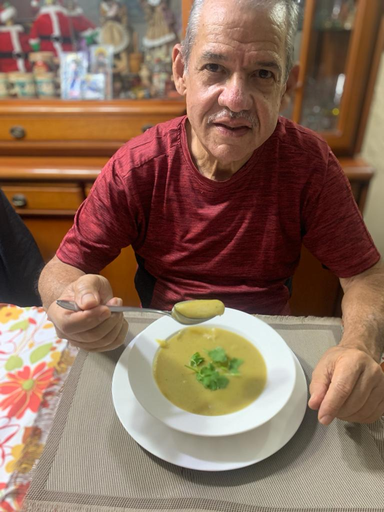


Cream of celery soup is a very tasty food preparation, rich in nutrients, vitamins and minerals; its pleasant taste satisfies the taste of children and adults; it can be used as a starter dish or as the soup of the main course at lunch. Don't forget to try it on one of those days when the stress of hard work or a cold bothers us to start the day; with a cream of celery in chicken or beef broth at breakfast, the day will be ready to start with energy.
Celery criollo is as it is known in Venezuela, or also arracacha, white carrot or racacha cultivated in other countries of America. Celery is a tuber rich in fiber that provides energy to the body and promotes the proper functioning of the digestive tract. Celery is rich in vitamins and minerals such as iron, calcium and phosphorus.


In this recipe we offer, we will combine the nutritional action of other vegetables such as white ocumo (malanga in other countries), carrot, ginger, ajoporro (leek), scallion, white onion, garlic, bell bell pepper and cilantro with which we will prepare a cream in beef broth.

The beef broth is prepared with three or four pieces of lizard with bone, as it is known in Venezuela, ossobuco or shank in other latitudes: it is the cut of the legs of cattle and other animals, which has a hollow bone with the marrow and the meat is fibrous. The marrow is a gelatinous component that constitutes the bone marrow, is a fat that has nutritional properties, consumed in moderate portions provides health benefits.
In a large pot we put about 2.5 liters of water and turn on the fire; we put the pieces of lizard (about 750 grams), two cloves of garlic, a medium onion chopped in four, a sweet bell pepper, a small carrot, half of a medium bell bell pepper and a sprig of celery (celery Spain) let it cook for 25 minutes; When it starts to boil, add a spoonful of salt and a small piece of ginger, the size of a clove of garlic, and let it boil for five more minutes.

While the broth is cooking we wash and chop the other vegetables: the Creole celery (about 750 grs.) is washed well with a rustic sponge and water, it is cut in small pieces; the white ocumo (250 grs.) is removed with a small knife all the shell and the white part is cut in medium pieces; the branches of garlic and chives are washed well and cut in two parts; the paprika and the chili are removed the seeds.

After the first 30 minutes of cooking the lizard, the fire is turned off and all the ingredients (meat and vegetables) are removed from the pot and only half of the broth is left in the pot (1 ½ liters, more or less); add the pieces of celery, ocumo and the ajoporro; add broth to completely cover these raw vegetables and turn on the fire. After 10 minutes, adjust the salt to taste and add the chives, sweet bell pepper and the other half of the paprika. When the broth boils, verify with a fork that the celery and the ocumo have softened; if so, add a sprig of cilantro and turn off the heat. With the help of a ladle, place the celery and okra pieces in a blender or food processor.

Add a little of the broth to facilitate blending. Make sure that the density or thickness of the preparation has the consistency of a cream and not a soup. Taste again for salt and, if it is to your taste, add a pinch of pepper. Reserve the rest of the broth and the other vegetables not used in the liquefied in another container for another preparation; pour the liquefied in the pot and turn on the slow fire, check the consistency of the cream and the salt, stir slowly with a paddle or wooden spoon; add more broth if you consider that the cream is too thick. Now is the time to add, if you like, 2 tablespoons of heavy cream or a tablespoon of cream cheese; stir slowly for a minute, turn off the heat and add a few cilantro leaves. Let stand for three or four minutes while you put the tablecloths and silverware on the table and call the diners. When serving the portions in bowls or deep plates, diners can add, to their taste, a teaspoon of grated cheese, white, Parmesan or pecorino with pepper; some people prefer to sprinkle a teaspoon of stale bread powder.
Bon appetit!


- Fotos de mi archivo personal
- Separadores elaborados en Canva
- 100% contenido original







